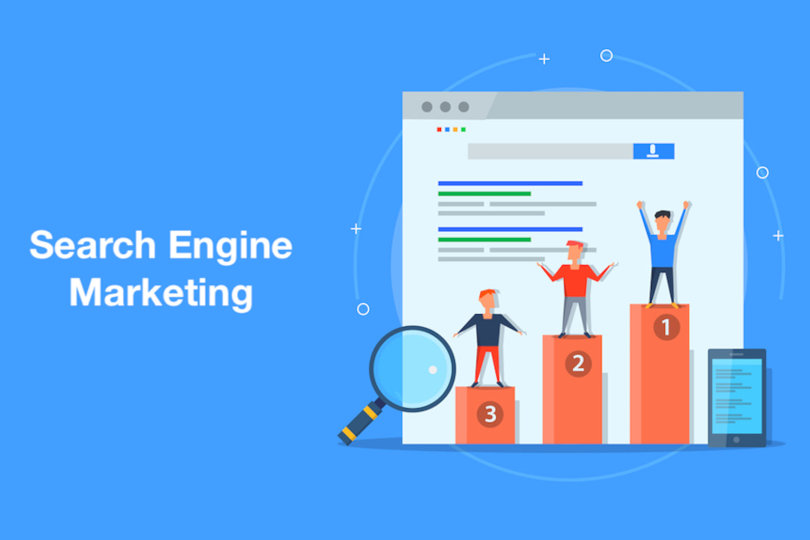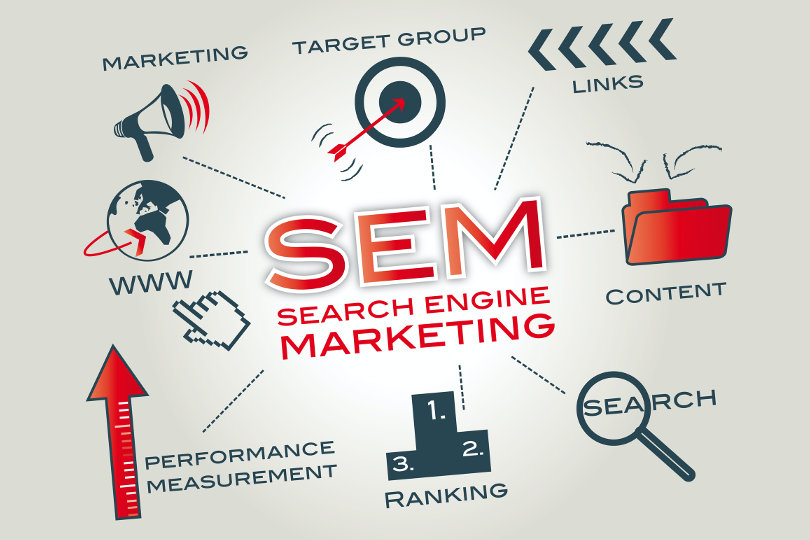When Google first introduced AdWords on October 23, 2000, it fundamentally altered the marketing landscape. By using AdWords’ search-based advertisements, businesses no longer need to spend a fortune for marketing and advertising, as their advertising would only be seen by individuals who were actively looking for products like theirs.
If you sell sneakers, you could simply show your advertisements to those who were searching for sneakers, and you would only need to pay when someone clicked on one of your ads. Search Engine Marketing (SEM) came into being at that time.

Since the year 2000, search engine marketing (SEM) has seen significant advancements (and what was formerly known as AdWords is now known as Google Ads), but the core principles have remained the same.
It continues to be an amazing marketing avenue for a lot of different brands.
What Exactly Does It Mean To Market On Search Engines?
The word search engine marketing, which is sometimes abbreviated as SEM and is similar to many other phrases in digital marketing, can be a little puzzling to those who are not familiar with it. Spending for advertising on search engines is the essence of search engine marketing or SEM for short.
The most significant difference between search engine marketing and search engine optimization is that SEM is not the same as SEO. There are two different approaches you may take in order to communicate with your clients through search engines (we’ll use Google as an illustration, but it could be any search engine, like Yahoo).
Search Engine Marketing is shorthand for advertising on Google
The term “search engine optimization” (SEO) refers to the process of making changes to your website in order for it to appear in the search results of Google “naturally” or “organically,” which means that you did not pay for that rank.
With SEM, your advertising might appear on the results page of a Google search almost immediately, as you are effectively bidding for placement on that page.
In comparison, it may take several months or even years for your SEO efforts to bear fruit and have you appear in the searches that you have targeted.
It is a widespread misunderstanding that search engine optimization and search engine marketing are the same things. Running search engine marketing campaigns has no effect on search engine optimization and vice versa.

The Most Important SEM Terminology
The following are some of the fundamental ideas that underpin search engine marketing:
Search Engine Results Pages (SERP)
When you Google something, you will arrive at this page, which contains the results of your search. The paid search results (SEM) and the organic search results (SEO) are both included in the SERP.
Keywords (KWs)
Through the use of keywords, you may communicate to Google which search terms—that is, what people actually put into Google—should cause your ads to be displayed.
There are two sorts of keywords used in search engine optimization: exact match keywords, which are very particular (e.g., “athletic green size 12 shoes”), and broad match keywords, which are much more general (e.g., “sport shoes”).
Negative keywords, on the other hand, do not target search queries but rather eliminate those terms from consideration. For instance, many businesses use the word “free” as a negative keyword in their advertising campaigns. This ensures that their advertisements do not appear in response to queries such as “free tennis shoes.”
Pay-Per-Click (PPC)
The majority of search ads are built on a basis of the pay-per-click (PPC) business model.
When Google first introduced AdWords, one of its most compelling unique value propositions was that users would only be charged for their advertisements when someone clicked on them.
Even though modern SEM campaigns aren’t necessarily paid per click, the concept of pay-per-click advertising and marketing is still widely used, and some individuals still refer to search engine marketing as pay-per-click (PPC) marketing.

How Exactly Does Marketing Using Search Engines Work?
Both search intent targeting and bid advertising are innovations that were made possible by Google’s AdWords programme. Both of these advancements shook up the marketing industry. You require an understanding of these two frameworks in order to comprehend how search engine optimization works:
Targeting based on search intent
The intent of the search is where marketers begin when developing search engine marketing campaigns. This necessitates identifying two crucial aspects, namely:
- What questions are our prospective clients or users want to get answered?
- In what stage of the buying process are they currently?
For instance, if a user searches for “fun methods to exercise outside,” this suggests that the user may eventually purchase tennis shoes, but that they aren’t necessarily in the industry for them at the time that they are conducting the search.
The purpose of this search is to find information related to working out and possibly wearing running shoes, but not to actually buy them. On the other hand, if the user searches for something along the lines of “best running shoes for narrow feet size 10,” it is clear that they are a lot closer to actually making a purchase.
This is because their search is much more particular. When it comes to purchasing tennis shoes, this search has been categorised as having “strong search intent.”
Typically, search engine marketing (SEM) campaigns are constructed to target the highest potential search intents by building ad groups that target either “branded” phrases (their own brand or their rivals’, such as “Nike running shoes”) or extremely precise “unbranded” (also termed “nonbranded”) searches for items or services (e.g., “athletic football shoes”).
Promotion through online auctions
The auction-based bidding system that Google developed was the company’s second major innovation. Advertisers typically purchase advertising space from a firm once the company has established its rate card for that space (for example, it can cost $10,000 to broadcast a 30-second commercial on a television show).
They couldn’t just establish a single fee for a search result because Google has billions of various ad spaces (Google conducts over 5 billion searches per day), each of which has its unique intention and quantity of users searching it each month.
Instead, Google developed a system that is based on auctions. Google conducts a real-time ad auction each and every time a search is performed on the website, and they “award” each available ad space on the search results page to an advertiser based on the result of the auction.
However, in contrast to a standard auction, it is not necessarily given to the person who places the highest offer.
It is given out based on a mix of the highest per-click spend and the ad’s “Quality Score,” which is an internal statistic developed by Google to evaluate the quality of advertisements (other search engines have similar metrics).
The Quality Score of an advertisement is based on a number of elements, including the following:
- The click-through rate (CTR) that is estimated asks the question, “Will the user click the ad when it is shown?”
- The degree to which your ad corresponds to the objectives of the particular search is referred to as its relevance.

How Helpful Is The User’s Landing Page Once They Click On Your Advertisement?
In a nutshell, Google evaluates the “fit” that your advertisement has for the user. This process is analogous to an auctioneer awarding the artwork to the highest bidder in whose home the auctioneer believes the picture will look the best.
An important part of an SEM marketer’s task is to obtain a high-quality Score (and a cheap cost-per-click) on their high-intent keywords. This can be accomplished by developing attractive ad copy and landing pages that are tailored to fit the keywords.
When Would It Be Beneficial For Your Company To Utilise SEM?
When you’ve found the right fit for your product, market, and messaging. The amount you have to pay for each click is based on your Quality Score.
A strong score is dependent on having ad copy that is meaningful to the people you want to attract as searchers. If you want to be successful with search engine marketing (SEM), you need to have an understanding of who your target is (product/market fit) as well as what appeals to them (industry fit).
If you haven’t precisely established this, Google may give you a low-quality Score. This means that you will be charged more for advertisements, and it will be harder for you to be successful.
When a category is being captured rather than when one is being created. Search engine optimization is dependent on targeted searches, which means that consumers have to be searching for the kind of product or service that you offer.
If you offer tennis shoes, this won’t be an issue for you because each month in the United States there are 135,000 people searching for “tennis shoes.”
If your product is developing a new category, such as a hybrid sports shoe/cosy slipper, then people are not yet searching for it; therefore, it will be considerably more difficult to discover the appropriate keywords to target with your marketing efforts.
You may establish category awareness through the use of various methods of marketing, and after the market has a better understanding of your product, you can begin running ads using search engine marketing.
Utilising Google’s Keyword Planner, you are able to conduct your own analysis on search queries relevant to your sector.

Conclusion
For good reason, advertisers annually pay close to $150 billion to Google for search engine marketing, making it one of the most expensive forms of performance marketing.
However, it is not just the use of keywords that makes it effective; the combination of the novel pay-per-click model, strong search intent, and auction-based pricing also contributes significantly.
If business owners and marketers have a solid understanding of these fundamentals, they will be able to start communicating with their prospective customers just as they are getting ready to make a purchase.







